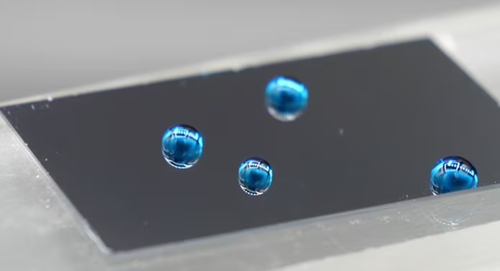‘Liquid-Like’ Coatings Offer PFAS Alternative
TUESDAY, AUGUST 29, 2023
Researchers from the University of Sydney have reportedly observed nano-thick “liquid-like coatings” with the potential for designing sustainable, self-cleaning materials. The findings were recently published in the chemistry journal Angewandte Chemie.
The study was led by Dr. Isaac Gresham with co-authors Professor Chiara Neto, honors student Seamus Lilley from the School of Chemistry and Sydney Nano, Dr. Kaloian Koynov from the Max Planck Institute for Polymer Research and Dr. Andrew Nelson from the Australian Centre for Neutron Scattering.
About the Coatings
According to the university’s release, the coatings the team studied are known as slippery covalently-attached liquid surfaces, or SCALS, which are produced from silicones or polyethylene glycol. Both of these materials can be broken down into harmless byproducts in the environment.
SCALS are reportedly anti-adhesive without relying on perfluorinated polymers (PFAS), also known as “forever chemicals.”
“These liquid-like layers are extremely slippery to most contaminants: they shed liquid droplets effortlessly, which is great to increase the efficiency of heat transfer and for collecting water, they prevent the buildup of scale, and resist the adhesion of ice and bacteria, bringing us one step closer to a self-cleaning world,” said Neto, who leads the Nano-Interfaces Laboratory at the university.

 |
| Isaac Gresham / University of Sydney |
|
Researchers from the University of Sydney have reportedly observed nano-thick “liquid-like coatings” with the potential for designing sustainable, self-cleaning materials. |
“We can correlate the exceptional performance of these layers with their nanostructure—meaning we now know what we’re aiming for when we design slippery surfaces, enabling us to make them even more effective and provide viable alternatives to fluorinated coatings.”
The nano-thin layers, the team explains, are two and five billionths of a meter thick or 10,000 times thinner than a human hair and are made up of oil molecules that are only a hundred atoms long.
“A water droplet glides with no friction over a thick oil film, but if you completely remove the oil film, say by using soap, most water droplets will stick to solid surfaces,” Neto said.
“How thin can the oil layer be on a solid surface before it is no longer ‘liquid-like’? At the nanoscale, the definition of a liquid becomes somewhat slippery.”
To study this, the researchers used two techniques to analyze the surface layers. The first was reportedly single-molecule force spectroscopy, which measures the length of individual molecules and the force required to stretch or compress them.
The second was neutron reflectometry, which allows scientists to measure the length and grafting density of molecules.
“We found that if the liquid molecules were too short and sparsely grafted on the solid surface, they did not adequately cover the underlying solid surface and remained sticky,” Neto said.
“On the other hand, if molecules were too long or grafted too densely, they did not have enough flexibility to act like a liquid. For SCALS to be effective, they needed to be in a Goldilocks zone, where they are neither too short nor too long, nor packed too loose or too tight.”
The team then measured the speed that a small probe molecule diffused inside the layer to definitively show the properties of the layers due to their “liquid-like” state. Neto said the fastest molecular diffusion was observed in the Goldilocks zone, where the oil molecules are just the right length and grafted with moderate density.
Other Self-Cleaning Paint Research
Earlier this year, in February, a student from Gdansk University of Technology in Poland developed a new hybrid paint that is not only magnetic, but can reportedly fight bacteria, remove stains and clean the air of harmful components. The material is anticipated to be effective for use in hospitals, health centers and schools.
The paint was created by Izabela Malinowska, a doctoral student from the Department of Process Engineering and Chemical Technology at the Faculty of Chemistry, under the supervision of professor Anna Zielinska-Jurek.
Zielinska-Jurek said that at the time, there was no product on the market that has the three properties of the paint—self-cleaning, biocidal and magnetic—at the same time. Researchers developed a finish product in various shades of brown, first applying the coatings in 2018 on drywall, and the properties have reportedly not changed so far.
According to the university’s release, the self-cleaning effect of the paint is triggered when it comes in contact with pollution. The photocatalytic additive present in the paint breaks down dirt, greasy contaminants and destroys pathogens, as well as cleans the air of volatile organic pollutants or harmful nitrogen oxides.
Zinc compounds in the composite structure create a strong biological barrier that prevents pathogens from developing on the surface, and bacteria strains were shown to be destroyed in a short time during testing. Malinowska said research was conducted on strains of gram-positive bacteria such as Staphylococcus aureus and gram-negative bacteria like Escherichia coli.
Artificial lighting is reportedly sufficient to activate the self-cleaning properties, with biological protection remaining active even when the light is turned off. Additionally, the paint can act as a magnetic board due to its magnetic properties.
Tagged categories: Coating chemistry; Coating Materials; Coating Materials - Commercial; Coatings; Coatings Technology; Coatings Technology; Coatings technology; Colleges and Universities; Green coatings; hydrophobic coatings; Research and development; Self-cleaning coatings







